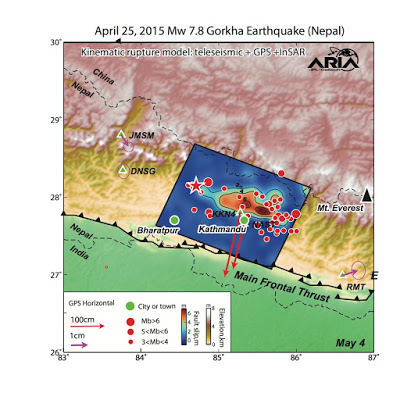
As a devastating earthquake ruptured Nepal on April 25, 2015, nearby GPS networks continuously recorded measurements at very close distances. In a new study, these data provide the scientific community with unique insights into megathrust earthquakes, which occur when two tectonic plates converge and one plate is forced underneath the other, and may help hazard assessment teams improve earthquake hazard models.
To better understand the sudden and intense changes megathrust earthquakes entail, John Galetzka et al. analyzed data from GPS stations located directly above the Main Himalayan Thrust (MHT) thrust fault (the unzipping of which contributed to the Nepal quake), as well as radar measurements that monitored surface displacements. The data from the 2015 earthquake event clearly indicate a pulse-like rupture that occurred over a mere six seconds, just a fraction of the total 70 second-duration of the earthquake.
Measurements reveal a slip pulse 20 kilometers (12.4 miles) wide, with an extremely fast rupture velocity of approximately 3.2km/s (2 miles/second). The smooth onset of the slip pulse limited shaking at frequencies likely to damage regular dwellings, but excited a basin-wide resonance responsible for the collapse of tall structures.
Reference:
“Slip pulse and resonance of Kathmandu basin during the 2015 Mw 7.8 Gorkha earthquake, Nepal imaged with geodesy,” by J. Galetzka; J.F. Genrich; S. Owen; J.-P. Avouac at California Institute of Technology in Pasadena, CA; D. Melgar at University of California, Berkeley in Berkeley, CA; J. Geng; E.O. Lindsey; X. Xu; Y. Bock at University of California, San Diego in La Jolla, CA; S. Owen; A. Moore at Jet Propulsion Laboratory in Pasadena, CA; J.-P. Avouac at University of Cambridge in Cambridge, UK; L.B. Adhikari; P. Shrestha; B. Koirala; U. Gautam; M. Bhatterai; R. Gupta; T. Kandel; C. Timsina; S.N. Sapkota; S. Rajaure; N. Maharjan. DOI: 10.1126/science.aac6383
Note: The above post is reprinted from materials provided by American Association for the Advancement of Science.










